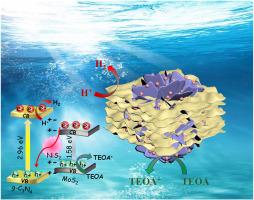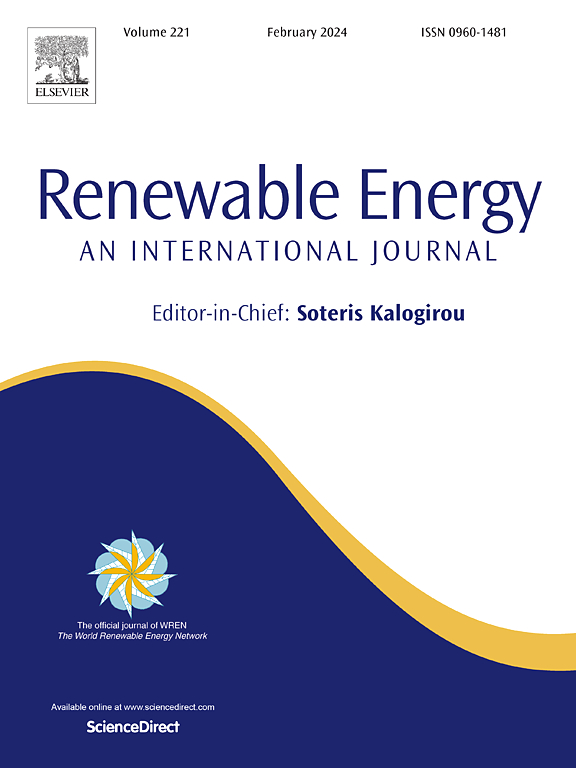以 NiS2 为电子介质的 MoS2-NiS2/g-C3N4 S 型光催化剂的高效 H2 演化
IF 9
1区 工程技术
Q1 ENERGY & FUELS
引用次数: 0
摘要
低成本的过渡金属硫化物具有优异的导电性和比表面积,通常被用作生产 H2 的光催化剂。本研究通过水热反应中 S2- 与 NiMoO4 在 Kirkendall 效应下的硫化反应,获得了具有多维空间结构的 MoS2-NiS2 纳米花。随后,利用溶剂自组装策略将 MoS2-NiS2 装载到 g-C3N4 纳米片表面,形成三维 MoS2-NiS2/g-C3N4 异质结。实验结果表明,在 300 W Xe 灯辐照下,20 wt% MoS2-NiS2/g-C3N4 的 H2 产率达到 22153 μmol g-1 h-1,分别是 MoS2-NiS2 和 g-C3N4 的 59.5 倍和 201.4 倍,超过了 20 wt% MoS2/g-C3N4 (211 μmolg-1 h-1)和 20 wt% NiS2/g-C3N4 (6183 μmol g-1 h-1)。XPS 和超氧自由基捕获实验表明,MoS2-NiS2 和 g-C3N4 之间的电荷转移遵循 S 型途径,NiS2 作为电子介质,促进电子从 MoS2 转移到 g-C3N4 上消耗空穴,从而提高了 g-C3N4 上 H2 演化反应的效率。此外,MoS2-NiS2/g-C3N4 的 S 型异质结具有多维几何结构,可为催化反应提供丰富的活性位点,这为开发具有成本效益和高性能的 g-C3N4 基异质结提供了一种前景广阔的方法。这项工作为可再生 H2 能源的发展轨迹提供了独特的视角。本文章由计算机程序翻译,如有差异,请以英文原文为准。

Efficient H2 evolution over MoS2-NiS2/g-C3N4 S-scheme photocatalyst with NiS2 as electron mediator
Low-cost transition metal sulfides are commonly utilized as photocatalysts for H2 production owing to their exceptional conductivity and superior specific surface area. In this study, MoS2-NiS2 nanoflowers with multidimensional space structure was obtained through the sulphuration reaction between S2− and NiMoO4 under Kirkendall effect during hydrothermal reaction. Subsequently, MoS2-NiS2 was loaded on the surface of g-C3N4 nanosheets using a solvent self-assembly strategy to form 3D MoS2-NiS2/g-C3N4 heterojunctions. The experimental results demonstrate that the H2 production rate of 20 wt% MoS2-NiS2/g-C3N4 reaches 22153 μmol g−1 h−1 under a 300 W Xe lamp irradiation, which is 59.5 and 201.4-folds than MoS2-NiS2 and g-C3N4, and surpasses 20 wt% MoS2/g-C3N4 (211 μmolg−1 h−1) and 20 wt% NiS2/g-C3N4 (6183 μmol g−1 h−1). The XPS and Superoxide radical capture experiments demonstrate that the charge transfer between MoS2-NiS2 and g-C3N4 follows the S-scheme route, and NiS2 functions as an electron mediator, facilitating the transfer of electrons from MoS2 to g-C3N4 to consume the holes, which enhances the efficiency of H2 evolution reaction on g-C3N4. Furthermore, the S-scheme heterojunction of MoS2-NiS2/g-C3N4 with the multidimensional geometric structure can provide abundant active sites for catalytic reactions, this presents a promising approach for the development of cost-effective and high-performance g-C3N4-based heterojunctions. This work offers distinctive perspectives on the trajectory of renewable H2 energy development.
求助全文
通过发布文献求助,成功后即可免费获取论文全文。
去求助
来源期刊

Renewable Energy
工程技术-能源与燃料
CiteScore
18.40
自引率
9.20%
发文量
1955
审稿时长
6.6 months
期刊介绍:
Renewable Energy journal is dedicated to advancing knowledge and disseminating insights on various topics and technologies within renewable energy systems and components. Our mission is to support researchers, engineers, economists, manufacturers, NGOs, associations, and societies in staying updated on new developments in their respective fields and applying alternative energy solutions to current practices.
As an international, multidisciplinary journal in renewable energy engineering and research, we strive to be a premier peer-reviewed platform and a trusted source of original research and reviews in the field of renewable energy. Join us in our endeavor to drive innovation and progress in sustainable energy solutions.
 求助内容:
求助内容: 应助结果提醒方式:
应助结果提醒方式:


